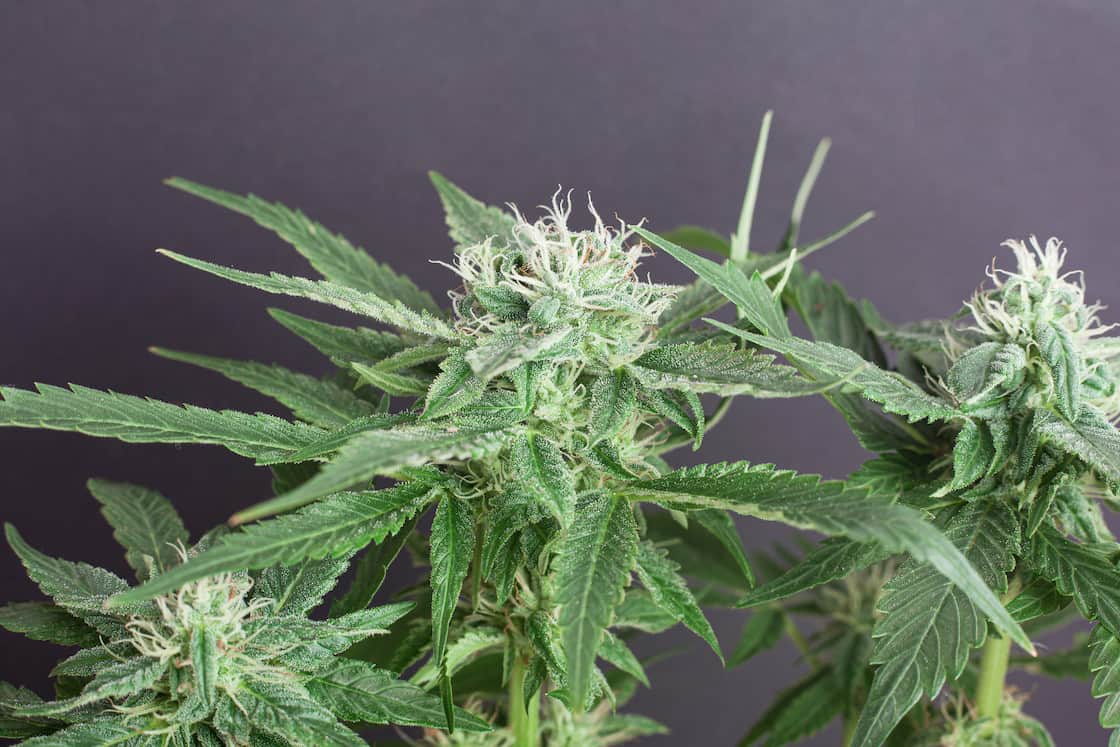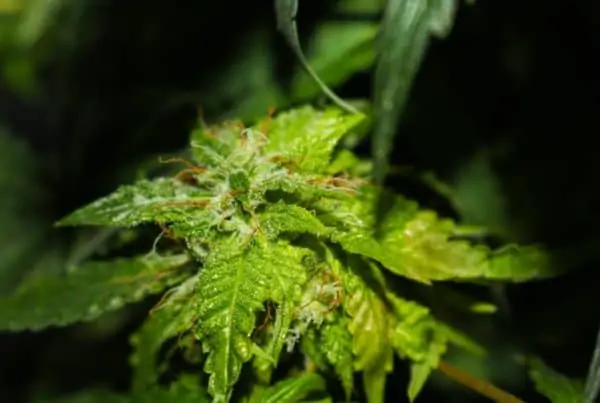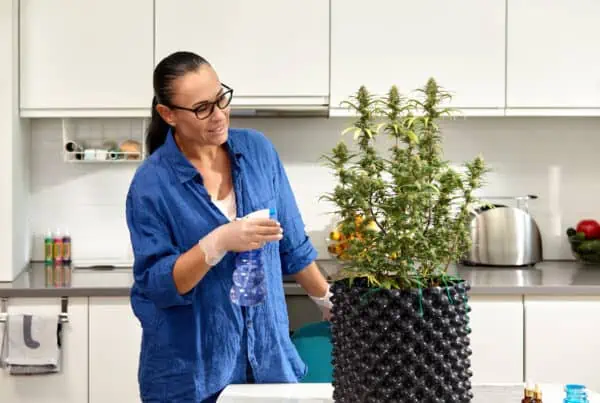TABLE OF CONTENTS
We've all seen the high-quality images of picture-perfect cannabis buds, completely covered in trichomes. But, are these connoisseur-grade flower nugs only possible at a commercial level? Absolutely not! You, too, can grow breathtaking flowering cannabis plants at home.
Our flowering cannabis guide takes you through every major aspect of the flowering stage. You'll learn when it starts, how long it takes, and the optimal garden conditions required for a healthy harvest. We’ll also break down the stage by weeks to show you how it's done.
Flowering Cannabis: Start & Duration
During the flowering stage, cannabis plants begin to form dense and resinous cannabis buds. However, there are many variables to consider when it comes to the beginning of the flowering stage and the length your cannabis plant remains in the stage.
- When growing outdoors, cannabis plants can begin the flowering stage when the daylight gets shorter around fall.
- Indoor cannabis plants begin to flower when the light cycle is switched to 12 hours of light and 12 hours of darkness.
- Autoflowering strains, unlike photoperiod plants, can begin flowering automatically after about four weeks (no light change needed).
How long the cannabis plants remain in the flowering stage depends on the genetics of the strain and their unique growing environment. Generally, cannabis plants can spend between 8 to 11 weeks in their flowering stage.
- Indica strains may remain in the flowering stage between 8 to 10 weeks.
- Sativa strains may remain in the flowering stage between 10 to 12 weeks.
- Hybrid strains may remain in the flowering stage between 6 to 10 weeks.
Determining the Sex of Your Cannabis Plants
If growing from regular seed, it is important to keep an eye out during the flowering stage to determine whether they are a male or female. Feminized seeds usually produce only female plants but there may be some males in the mix.
Generally, the first signs of flowers can begin to appear after the fourth week of vegetative growth from seed. You can find the pre-flower formation at the nodes where branches grow from the stem. Use a magnifying glass or loupe to get a better look at the pre-flower.
- Generally, female pre-flowers produce two pistils, but not always.
- Male pre-flowers produce sex organs that look like small balls.
- Hermaphrodite cannabis plants have both sex organs.
It is important to remove the males as soon as possible to avoid cross-pollination and lowering the quality of your flowering cannabis. Learn more about identifying your male and female plants with our blog resource.
Optimal Garden Conditions for Cannabis Flowering
Cannabis plants require unique growing conditions that vary depending on their growth stage. While certain lighting and nutrient requirements may work for one stage, the same amount of nutrients and light may not for another.
During the flowering stage, these are the optimal indoor garden growing conditions for your grow room.
- Temperature: 75º F (24º C) +/- 2º
- Light: 12 hours of light; 2700 K; MH or LED bulb
- RH%: 45% (+/- 5%)
- Nutrients: Low N, High P, Medium K
- CO2: None
The Flowering Stage: Week-by-Week
Here, we will show you what to expect throughout the flowering stage as the weeks go by, so you can have a successful harvest by the end.
Week 1-3
When your cannabis plants start getting at least 12 hours of darkness without any light leaks it will induce flowering and grow considerably in size and height. Expect your plans to nearly double in height during this transition phase. Give your plants plenty of water to promote this growth spurt.
The female cannabis plants may start growing their white pistils but you won't see any major bud formation right away. If you see any pollen sacs from male plants, immediately remove the male plants from your garden to avoid cross-pollination.
Between week 1 and 3 of the flowering stage, you may see single leaf formation at the top of the main colas at the top of the plant. If necessary, you may gently bend the growing stems down to create an even canopy, known as low stress training.
Week 3-4
During the week 3 and 4, the growth spurt will begin to slow down. During these weeks, you will see bud formations in addition to the pistil hairs.
Watch out for any signs of nutrient deficiencies such as discolored leaves or foliage loss. You may also experience nutrient burn if you overfeed your cannabis plants nutrients. Nutrient burn will show up as burnt leaf tips.
During these weeks, you may also notice a change in the aroma of your plants, especially in marijuana strains known for their pungent aroma.
Week 4-6
During these weeks your bud will start to become bigger and more dense. The vertical growth will be nearly done. If the bud starts to get too heavy, you may need to add support for these heavy branches.
At this point, you may want to defoliate in certain areas to expose buds to the light. Just don't go overboard. Your plant still needs leaves to promote bud growth.
Week 6-8
By this point, foliage growth will stop and your plant will be focused on bud growth. You may notice yellowing of leaves, which is normal since the energy is being directed to the growing marijuana buds.
Week 8+
From week 8 and beyond, your plant is almost done growing. At this point, some growers do a last flush that involves only feeding plain water to your plants. You can flush your plants during the last few days or a few weeks before they are ready for harvest.
During this time, your trichomes are reaching peak maturity. Do you want to know when to harvest? Read our blog resource for the best time to harvest to understand when the trichomes’ maturity are at their peak.
Yellowing leaves are normal and occur toward the end of harvest. Do not increase nutrient levels to battle the yellowing, since it can reduce your bud quality.
“
There are over 300,000 jobs in the cannabis industry. CTU trained me for one of them!

Makes $24.50 @ THC +
Become a Cannabis Plant Growing Expert
Growing a successful cannabis garden takes patience, skill, and care. Enroll in Cannabis Training University’s online marijuana education courses to learn growing techniques from the world's best cannabis growers.
Our online-based curriculum takes you through every step of the cultivation process from planting the seed to harvesting the buds to creating a wide range of extracts and infusions from your yield.
Certification from CTU can also help you find a job in any sector of the cannabis industry, including cannabis cultivation. Start your new career today!

Luis Cordova
Luis Cordova is a distinguished author, and renowned expert in cannabis cultivation, who possesses a Master's degree in Plant Biotechnology and Pharmaceutical Science. As a valued contributor to highly esteemed publications such as Cannabis Training University and Maximum Yield Magazine, Luis has emerged as a trusted source of guidance and knowledge in the cannabis industry. Having written thousands of informative articles, Luis is widely recognized for his comprehensive expertise on cultivating cannabis, both indoors and outdoors.












 Jeff was involved in an accident where he endured a traumatic brain injury. He had a week-long stay in ICU where brain surgeons
Jeff was involved in an accident where he endured a traumatic brain injury. He had a week-long stay in ICU where brain surgeons  100% risk free money back guarantee within 48 hours after purchase if student has not completed any of the courses or exams.
100% risk free money back guarantee within 48 hours after purchase if student has not completed any of the courses or exams.